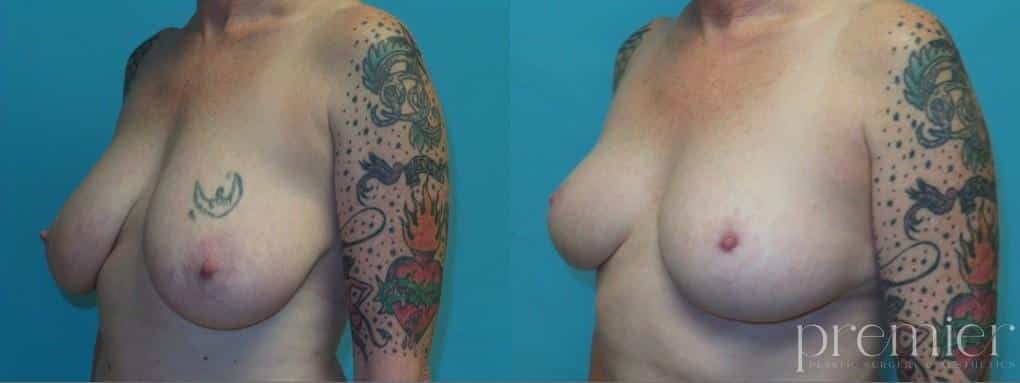Bigger is not always better, as many large-breasted women have learned. Dr. Brou can help ease the physical and emotional burden caused by large or heavy breasts with a breast reduction in Oklahoma City.
Breast reduction, also known as reduction mammaplasty, is a procedure to remove excess breast fat, glandular tissue and skin to achieve a breast size more in proportion with your body and to alleviate the discomfort associated with excessively large breasts (macromastia).
Disproportionately large breasts can cause both physical and emotional distress for patients. Patients with macromastia may experience physical discomfort resulting from the weight of their breasts. The resulting pain can make it challenging for some patients to perform common physical activities. Along with the physical ailments of macromastia, some patients may suffer from emotional distress or more significant mental health problems as a result of their large breasts.
Although breast reduction is often performed to address medical issues, patients who do not have the symptoms of macromastia but are unhappy with the size of their breasts can still pursue breast reduction as an aesthetic procedure. Patients choosing to undergo breast reduction surgery for cosmetic reasons may cite any number of factors, including social stigmas and wardrobe concerns.
Overly large breasts can cause health and emotional problems. In addition to self-image issues, you may also experience physical pain and discomfort. The weight of excess breast tissue can impair your ability to lead an active life. The emotional discomfort and self-consciousness often associated with having large pendulous breasts can be as important an issue as the physical discomfort and pain.
You may be a candidate for breast reduction surgery if:
- You are physically healthy
- You have realistic expectations
- You don’t smoke
- You are bothered by feeling that your breasts are too large
- You have breasts that limit your physical activity
- You experience back, neck and shoulder pain caused by the weight of your breasts
- You have shoulder indentations from bra straps
- You have skin irritation beneath the breast crease
The success and safety of your breast reduction procedure highly depends on your complete candidness during your consultation. Dr. Brou will ask you a number of questions about your health, desires and lifestyle.
During your breast reduction consultation be prepared to discuss:
- Why you want the surgery, your expectations and desired outcome
- Medical conditions, drug allergies and medical treatments
- Use of current medications, vitamins, herbal supplements, alcohol, tobacco and drugs
- Previous surgeries
- Family history of breast cancer and results of any mammograms or previous biopsies
Dr. Brou will evaluate your general health status and any pre-existing health conditions or risk factors. He will also examine your breasts, and may take detailed measurements of their size and shape, skin quality, placement of your nipples and areolas as well as take photographs for your medical record. Afterwards Dr. Brou will discuss your options and recommend a course of treatment as well as discuss likely outcomes of your breast reduction procedure and any risks or potential complications.
You will also have an opportunity to meet with our patient coordinator to get exact pricing and financing options if you choose to schedule surgery.
Breast reduction surgery is usually performed through incisions on your breasts with surgical removal of the excess fat, glandular tissue and skin. Dr. Brou uses surgical incisions much like that of a breast lift and in some cases he may remove excess fat with liposuction as well. After the incision is made, the nipple (which remains tethered to its original blood and nerve supply) is then repositioned. The areola is reduced by excising skin at the perimeter, if necessary.
Underlying breast tissue is reduced, lifted and shaped. Occasionally, for extremely large pendulous breasts, the nipple and areola may need to be removed and transplanted to a higher position on the breast (free nipple graft).
The incisions are brought together to reshape the now smaller breast. Sutures are layered deep within the breast tissue to create and support the newly shaped breasts; sutures, skin adhesives and/or surgical tape close the skin. Incision lines are permanent, but in most cases will fade and significantly improve over time.
The technique used to reduce the size of your breasts will be determined by your individual condition, breast composition, amount of reduction desired, your personal preferences and Dr. Brou’s advice.
Breast reduction is performed under general anesthesia in the outpatient surgery center Oklahoma Surgicare in Oklahoma City (across the turnpike from Mercy hospital). This surgery is outpatient and no overnight stay is required.
For the first two weeks following your breast augmentation procedure, you may experience some discomfort, tightness and swelling in the chest. Dr. Brou will prescribe oral medication to help with the pain, which should dissipate in about a week. You can expect to return to work after one to two weeks, with some limitations. To stabilize your new breasts, you will wear a support bra around 4 weeks.
The results of breast reduction surgery will be long-lasting. Your new breast size should help relieve you from the pain and physical limitations experienced prior to breast reduction. Your better-proportioned figure will likely enhance your self-image and boost your self-confidence. However, over time your breasts can change due to aging, weight fluctuations, hormonal factors and gravity.

